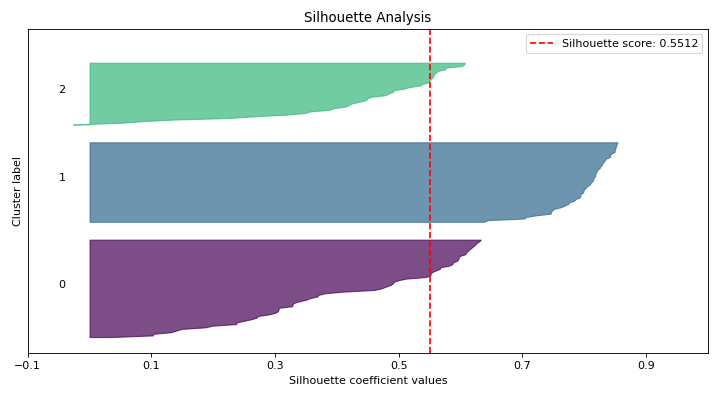plot_silhouette#
- scikitplot.api.metrics.plot_silhouette(X, cluster_labels, *, metric='euclidean', title='Silhouette Analysis', title_fontsize='large', text_fontsize='medium', cmap=None, digits=4, **kwargs)[source]#
Plots silhouette analysis of clusters provided.
Silhouette analysis is a method of interpreting and validating the consistency within clusters of data. It measures how similar an object is to its own cluster compared to other clusters.
- Parameters:
- Xarray-like, shape (n_samples, n_features)
Data to cluster, where
n_samplesis the number of samples andn_featuresis the number of features.- cluster_labelsarray-like, shape (n_samples,)
Cluster label for each sample.
- metricstr or callable, optional, default=’euclidean’
The metric to use when calculating distance between instances in a feature array. If metric is a string, it must be one of the options allowed by
sklearn.metrics.pairwise.pairwise_distances. IfXis the distance array itself, use “precomputed” as the metric.- copybool, optional, default=True
Determines whether
fitis used onclfor on a copy ofclf.- titlestr, optional, default=’Silhouette Analysis’
Title of the generated plot.
- title_fontsizestr or int, optional, default=’large’
Font size for the plot title.
- text_fontsizestr or int, optional, default=’medium’
Font size for the text in the plot.
- cmapNone, str or matplotlib.colors.Colormap, optional, default=None
Colormap used for plotting. Options include ‘viridis’, ‘PiYG’, ‘plasma’, ‘inferno’, ‘nipy_spectral’, etc. See Matplotlib Colormap documentation for available choices.
https://matplotlib.org/stable/users/explain/colors/index.html
plt.colormaps()
plt.get_cmap() # None == ‘viridis’
- digitsint, optional, default=4
Number of digits for formatting output floating point values.
Added in version 0.3.9.
- **kwargs: dict
Generic keyword arguments.
- Returns:
- axmatplotlib.axes.Axes
The axes on which the plot was drawn.
References * “scikit-learn silhouette_score”.#
- Other Parameters:
- axmatplotlib.axes.Axes, optional, default=None
The axis to plot the figure on. If None is passed in the current axes will be used (or generated if required).
Added in version 0.4.0.
- figmatplotlib.pyplot.figure, optional, default: None
The figure to plot the Visualizer on. If None is passed in the current plot will be used (or generated if required).
Added in version 0.4.0.
- figsizetuple, optional, default=None
Width, height in inches. Tuple denoting figure size of the plot e.g. (12, 5)
Added in version 0.4.0.
- nrowsint, optional, default=1
Number of rows in the subplot grid.
Added in version 0.4.0.
- ncolsint, optional, default=1
Number of columns in the subplot grid.
Added in version 0.4.0.
- plot_stylestr, optional, default=None
Check available styles with “plt.style.available”. Examples include: [‘ggplot’, ‘seaborn’, ‘bmh’, ‘classic’, ‘dark_background’, ‘fivethirtyeight’, ‘grayscale’, ‘seaborn-bright’, ‘seaborn-colorblind’, ‘seaborn-dark’, ‘seaborn-dark-palette’, ‘tableau-colorblind10’, ‘fast’].
Added in version 0.4.0.
- show_figbool, default=True
Show the plot.
Added in version 0.4.0.
- save_figbool, default=False
Save the plot.
Added in version 0.4.0.
- save_fig_filenamestr, optional, default=’’
Specify the path and filetype to save the plot. If nothing specified, the plot will be saved as png inside
result_imagesunder to the current working directory. Defaults to plot image named to usedfunc.__name__.Added in version 0.4.0.
- overwritebool, optional, default=True
If False and a file exists, auto-increments the filename to avoid overwriting.
Added in version 0.4.0.
- add_timestampbool, optional, default=False
Whether to append a timestamp to the filename. Default is False.
Added in version 0.4.0.
- verbosebool, optional
If True, enables verbose output with informative messages during execution. Useful for debugging or understanding internal operations such as backend selection, font loading, and file saving status. If False, runs silently unless errors occur.
Default is False.
Added in version 0.4.0: The
verboseparameter was added to control logging and user feedback verbosity.
Examples
>>> from sklearn.datasets import make_blobs >>> from sklearn.cluster import KMeans >>> from sklearn.datasets import load_iris as data_3_classes >>> import scikitplot as skplt >>> X, y = data_3_classes(return_X_y=True, as_frame=False) >>> kmeans = KMeans(n_clusters=3, random_state=0) >>> cluster_labels = kmeans.fit_predict(X) >>> skplt.metrics.plot_silhouette( >>> X, >>> cluster_labels, >>> );
(
Source code,png)
